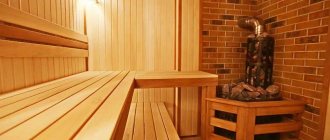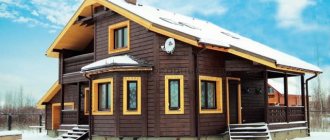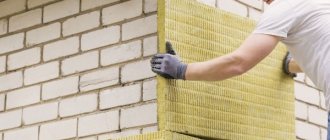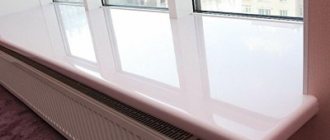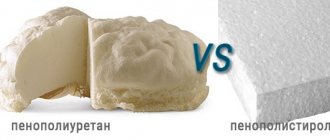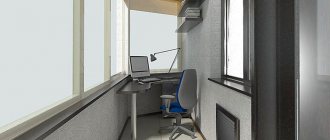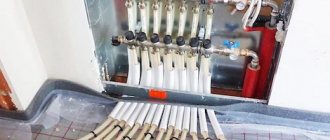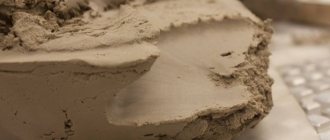It is important to immediately warn that the insulation of a room located under the roof of a private house must be approached as responsibly as possible. If you do not insulate or make mistakes when insulating, you will definitely face serious consequences. And it is important to know how to insulate an attic, since this is a responsible and significant undertaking.
The problem with poor-quality insulation is that cold wind blows through the cracks, and condensation accumulates in the rafter system. As a result, everything rots, blooms, and gradually collapses.
Plus, heating costs will be higher, since the roof is not properly protected, the insulation does not work, and the decoration, which plays a decorative role, cannot cope with heat retention.
So the room itself, that is, the attic, roof and other surfaces must receive high-quality and effective insulation. How to fulfill this condition? To do this, it is necessary that the work proceeds in stages and with an understanding of what result you are striving for.
Today we’ll talk about insulating the attic from the inside if the roof is already covered. Of course, it is best to provide thermal insulation at the construction stage. But the attic is not always initially planned as a living space. Many people, when buying ready-made houses, make another room out of the attic. And it will be simply necessary to insulate the attic here.
Selecting the necessary materials for attic insulation
Each attic has its own design and structure. Materials are selected individually for each room. For internal insulation of the attic, sheet types of heat insulators are used. These include mineral wool, polystyrene foam, penofol, polyurethane foam. They use expanded polystyrene - foam that is applied without preliminary preparation of the walls. In addition to insulation, waterproofing materials are installed to protect the walls from moisture and condensation.
The main materials used to insulate the attic inside:
- Penofol is foamed polyethylene. It has high sound insulation ability, aluminum coating, and low thermal conductivity.
- Polystyrene foam does not absorb moisture, retains heat, and has a low price. Due to low vapor permeability, fungus forms on the frame. The room becomes stuffy and hot, the foam easily catches fire.
- Expanded polystyrene is similar in characteristics to polystyrene foam, but has a denser structure. The difference is that polystyrene foam is placed between the rafters, and polystyrene foam is placed on them. The material is strong, durable, does not contain fire retardants, but does not allow air to pass through well and can burn.
- Polyurethane foam is a foam material with a service life of up to 30 years. It is not subject to shrinkage, does not absorb moisture, and does not require a vapor barrier layer. Installation requires expensive equipment and extensive experience.
- Mineral wool is an environmentally friendly and safe material, often used for attic insulation, and lasts up to 50 years. Cotton wool has low thermal conductivity, absorbs sound well, does not burn, weakly absorbs moisture and dries quickly. Unlike polystyrene foam, mineral wool is heavier, it requires a strong frame, and the material can be deformed. But rodents and insects do not like it.
Attention!
When choosing a material, the characteristics of the insulation are taken into account - service life, weight, noise insulation, thermal conductivity, hygroscopicity and environmental friendliness. The thickness of the walls, the dimensions of the structure, and the roof covering are also important.
Thickness calculation
The minimum thickness of insulation for an attic depends, first of all, on the design of the roof , on how much it can resist the transfer of heat from a heated to a cold source. This indicator is also influenced by the climatic characteristics of the development area and the heat-shielding properties of the insulation.
In order to take all these parameters into account together, the following formula is used to calculate the thickness of the heat insulator.
In some cases, for rough calculations you can use a more simplified version of the formula for the thickness of the thermal layer:
σ ut. = (R - 0.16)х λ jут , in which:
- σ ut . — heat insulator thickness, m;
- R —heat resistance of the structure for a certain climatic region, m2*C/W;
- λ ut — thermal conductivity of the insulation, W/(m*C).
An example of calculating the minimum thickness of mineral wool for the attic of a residential building located in the Moscow region:
R= 4.67 m2*C/W.
λ ut = 0.034 W/ (m C).
σ ut. = (4.67 - 0.16)x0.047 = 0.211 m.
Differences for seasonal summer and winter residence
Attics with year-round living are when residents are constantly in the house throughout the entire calendar year. They differ from seasonal premises in the presence of heating systems.
Some users incorrectly believe that the main difference between these two terms is the presence or absence of a thermal insulation layer in the roof slopes. After all, even with seasonal use of the attic, the roof must be thoroughly insulated.
The only significant difference in these options is the location of the thermal insulation layer:
- When constructing seasonal summer premises, a heat insulator is installed on top of the attic floor, and the roofing system remains uninsulated.
- When organizing a residential attic, insulation is installed in the roof slopes, and the attic floor is built using interfloor technology, placed between two heated floors.
Important ! The thickness of the insulation in both options is the same and is determined by the climatic characteristics of the area.
Insulating the attic from the inside if the roof is metal and it is already covered
If the roof is already covered, work on insulating the attic is moved indoors. Metal, unlike wood, retains cold. Therefore, in winter it will be very chilly, and in summer the metal surface will warm up very much and the room will become hot and stuffy. For a metal roof, wood must be used at least partially. They make a wooden sheathing and lay insulation.
Roof insulation scheme:
- Metal tiles.
- Waterproofing membrane.
- Insulation.
- Vapor barrier.
- Drywall.
The walls in the attic must have a waterproofing barrier. The attic is insulated with mineral wool; it is not afraid of heating the metal roof and retains heat well in winter. Mineral wool and polystyrene foam go well together. Lay waterproofing, polystyrene foam, cotton wool and again a layer of waterproofing.
Choosing insulation for an attic roof
If you are insulating a room yourself, then one of the most difficult tasks is choosing insulation. There is such a huge range of types and brands of materials on the building materials market that you simply get lost.
When I decided to insulate the attic, I had a choice between polystyrene foam and mineral wool. However, it turned out that there are many more insulating materials, and each has its own pros and cons.
A master builder with 20 years of experience advised me to choose insulation for the attic for winter living in accordance with the following requirements:
- thermal conductivity coefficient no more than 0.04 W/mS;
- noise absorption coefficient from 0 to 1;
- vapor permeability not higher than 0.5 mg/(m*h*Pa);
- fire safety class NG or G1;
- load reliability factor is about 1.3 Yf;
- environmental safety close to class A;
- efficiency;
- no difficulties during installation.
Below we will consider in detail which insulation materials meet these requirements.
Styrofoam
Polystyrene foam is made by foaming polymers. The bulk of polystyrene foam consists of air, so it has low weight and good thermal insulation properties. The positive qualities include moisture resistance, excellent sound insulation and low cost.
Foam plastic retains its performance properties in a fairly wide range from -50 to +75 °C. There are no problems when working with it. Polystyrene foam can be easily cut with a knife, and it can be attached to the surface using glue.
Disadvantages include the fragility of the material. During the cutting process, the edges of the foam crumble, so there are gaps at the joints where cold bridges can form. The main disadvantage of polystyrene foam is its high flammability, so it cannot be used in areas with a high fire hazard.
Extruded polystyrene foam
During the production process, expanded polystyrene is subjected to high-temperature treatment, due to which, despite the small thickness of the material, it has high heat-shielding properties and good strength. With all the positive properties, the material also has disadvantages. The cost of this insulation is approximately 2 times higher than the cost of polystyrene foam. The material is made from plastic, so it cannot be called environmentally friendly.
Although manufacturers claim that polystyrene foam is resistant to fire, practice shows the opposite. As for sound insulation, compared to polystyrene foam and mineral wool, polystyrene foam has lower performance.
Mineral wool
Mineral wool has a fibrous structure and is available in rolls and mats. It is made from natural ingredients with a small amount of synthetic binders, and therefore is highly environmentally friendly.
It has high heat-protective and sound-proofing qualities. This is especially important if there is a bedroom in the attic. Agree, it’s difficult to sleep when rain is drumming on the roof. Insulating the roof with mineral wool solves this problem.
Mineral wool is not afraid of fire and high temperatures, melts only at a temperature of 1000 °C, so it is often chosen for insulating wooden houses. It is highly resistant to temperature changes and chemicals. At the same time, the material has a low cost, on average about 600 rubles per square meter. m.
The main disadvantage of mineral wool is its increased hygroscopicity, so it requires mandatory waterproofing.
Hygroscopicity is the ability of insulation to absorb moisture from the environment.
Glass wool
Glass wool is a type of mineral wool. Its difference lies in its production technology; it is made from molten glass. It has the same pros and cons as mineral wool.
Stone wool
Basalt, or stone wool, is made from molten rocks. It is also a derivative of mineral wool, and therefore has the same qualities as the previous two.
Ecowool
Ecowool is a relatively new type of insulation, which is made from cellulose waste. The material consists of 80% loose paper fiber, the remaining 12% is a natural antiseptic boric acid and 8% is borax, which is added to reduce the attractiveness of ecowool for insects and rodents.
Ecowool has low water permeability and a high degree of sound insulation due to hollow holes in the insulation fibers, which absorb sound and do not allow moisture to pass through. Since synthetic materials are not used in the production of ecowool, it is environmentally friendly.
The level of thermal protection of ecowool is approximately the same as that of mineral wool. When wet, the insulation does not lose its protective properties. Has good adhesion to almost any material.
The disadvantages include low rigidity, which requires the installation of additional supporting structures. The material has a high shrinkage (after 2 years it sags significantly), so experts recommend increasing the ecowool layer during installation by 30% of the calculated value.
Ecowool, although it does not burn, does smolder, so it cannot be called completely fireproof. The relatively low price of the material (from 50 rubles per kg) is offset by the high cost of installation. For work on ecowool insulation, specialists charge from 1000 rubles per 1 sq. m. m. Without special additional equipment, it will not be possible to insulate the attic with ecowool yourself.
Polyurethane foam
Polyurethane foam is a sprayed insulation material, it is obtained by the synthesis of two components: a polyol and a polyisocyanate. During the reaction, carbon dioxide is intensively released, resulting in a foamed, dense insulating material.
Thanks to its dense porous texture, it provides good thermal protection. For comparison: the thermal conductivity of polyurethane foam is 0.02 W/m, and that of mineral wool is 0.05 W/m. PPU has higher sound insulation rates compared to other insulation materials, as it has a higher density and cellular structure.
Due to the continuous application there are no joints, so cold bridges do not form in it. Using polyurethane foam you can insulate the most complex structures and shapes.
The insulation has excellent adhesion to all types of materials, except polyethylene. It is a non-combustible material and is a leader among other insulation materials in terms of moisture resistance. It has high performance properties and can withstand temperatures ranging from -160… +150 °C.
The downside is the labor-intensive installation technology, which does not allow you to do the work yourself. Insulation requires specialized installation equipment and is expensive. Application with a layer of 15 cm will cost you from 1200 rubles/sq.m. m.
Since polyurethane foam is a vapor-proof material, an attic insulated with it will need forced ventilation.
Penofol
The insulation consists of foamed polyethylene, covered on one or both sides with aluminum foil. Penofol is popular because with a small thickness of the material - from 2 mm to 4 cm - it has high heat-protective, vapor barrier and noise-reducing properties.
Aluminum foil covering penofol reflects thermal radiation, while polyethylene foam, on the contrary, absorbs thermal energy. This combined technology allows you to reliably insulate the room. Aluminum foil and polyethylene foam have a vapor permeability below 0.001 mg/(m*h*Pa), so it reliably protects the structure from evaporation.
The insulation does not require additional waterproofing. It is light in weight, easy to cut with a knife and easy to install. Environmentally friendly. Penofol is a highly flammable material. The average price for penofol is about 100 rubles/sq.m. m.
Among the disadvantages, it is worth noting the low rigidity of the material, so it will not be possible to apply finishing materials directly to it. Penofol should be used carefully in places where electrical wires and equipment come into contact, as it is a conductor of electricity.
How to insulate an attic with penofol
Foamed polyethylene is heat sealed to the foil on one or both sides. The thickness varies - from 3 to 10 mm. Most often it is used as an additional material to the main insulation. Polystyrene foam or cotton wool is inserted into the sheathing and covered with penofol on top.
Work progress:
- Measure and cut a strip of penofol.
- Using a stapler, the material is attached to wooden slats end-to-end without overlap, with foil inside the room.
- The joining seam is covered with aluminum tape.
- Slats are placed on top of the insulation and covered with sheets of plasterboard.
Penofol can be used to insulate the attic and all its internal surfaces: walls, ceiling, floor. There is a self-adhesive material on sale that has an adhesive layer and is easy to attach.
Waterproofing installation process
Ideally, waterproofing is installed as follows:
- material wraps the rafters;
- laid close to the insulation.
Waterproofing is often rolled out over the rafters to save money, not stretching, but creating a sag of several centimeters. This option can also be considered good, since moisture falls on the surface, after which it rolls down and leaves the roof. Another important point is the exit of the membrane into the drainage gutter. Due to this, moisture will move out from the under-roof space.
A number of aspects of membrane installation can be highlighted. It is laid across the rafters starting from the bottom. The first option is launched into the gutter. The next layer is rolled out to the ridge. On the membrane ridge, the material is pulled on both sides along the upper edge, after which it is fixed. A strip is rolled out lengthwise along the ridge. It goes down from one and the other side of the roof. A coating is formed along which water can flow directly to the drainage gutter.
Do-it-yourself insulation of the attic from the inside with mineral wool
Mineral wool absorbs moisture, so a waterproofing layer is necessary. The film is laid with an overlap (10 cm) so that one sheet overlaps the other. The waterproofing is attached to the wood with a stapler and tape. For the lathing, wooden slats 8 cm wide are used. They are attached to the rafters parallel to each other at a distance of 50 cm.
Work in stages:
- The walls are covered with thermal insulation.
- Mineral wool is laid out on the floor, the required length is measured, and cut. It is equal to the gap between 2 rafters plus a 2 cm margin so that the insulation lies tightly.
- Insert the cut piece between the rafters.
- The cross slats are fastened with self-tapping screws; they fix the material. Instead, you can pull ropes.
- Cover with a vapor barrier and nail the film.
- A finishing coating is installed on top.
Advice!
If one layer of cotton wool is not enough, you can put 2 pieces of material; a two-layer installation in winter will prevent the cold from penetrating into the room.
Insulation of the attic with polystyrene foam
Expanded polystyrene is a lightweight material; it is attached to the surface with adhesive mixtures and mastic. For classic buildings with vertical walls, polystyrene foam with a thickness of 75-100 mm is used if the roof is not insulated. For a warm roof, slabs 50 mm thick are suitable. For attic insulation, 2 layers of material are laid.
Laying material:
- The bottom of the rafters is sheathed with plywood or boards, without gaps.
- A vapor barrier is placed on the base and secured with tape. Be sure to lay it on the side indicated in the instructions.
- The slabs are cut to a size equal to the distance between the rafters.
- Lay the cut sheets of expanded polystyrene correctly, trying to leave small gaps between the insulation and the insulation.
According to the technology, before laying the penoplex, a sheathing is made so that there is an air channel between the roof surfaces and the insulation. In this case, water vapor will not settle on surfaces.
Insulation of the attic with polyurethane foam
Polyurethane foam has good adhesion to surfaces, leaving no gaps or air pockets. It does not require waterproofing or other insulating materials. The foam is applied directly to the attic walls. The installation consists of a compressor, hoses, and valve. The unit is turned on, foam is blown out of the hose, and the material is uniformly sprayed between the rafters. The components used to fill the installation are mixed 1:1. Analogues of polyurethane foam are liquid penoplex and recycled cellulose.
Before applying polyurethane foam, you need to take care of ventilation inside the building. When working, wear goggles, overalls, gloves and a respirator. Do not allow foam to get on exposed parts of the body. Breathing polyurethane vapors is harmful to health.
Advice!
To cover the walls with foam yourself, before work it is better to watch a video on the Internet and consult with specialists.
The main mistakes in insulating the attic
When laying insulation and vapor barrier layers, you need to take into account the region of residence. In case of frequent rains and cold weather in the area, 3-4 thermal insulation layers are provided to insulate the attic. Depending on the climate, the dimensions and thickness of the material are selected. So, in the northern part of the country, the thickness of thermal insulation should be at least 200 mm.
There are certain mistakes that are often made when installing insulation yourself; they depend on the properties of the materials and the features of their installation:
- Mineral wool shrinks; this must be taken into account when laying. For installation, cut the sheets 2-3 cm more than the distance between the boards. If you do not put waterproofing material, the wool will become saturated with moisture, settle, and heat will not be retained well. You cannot lay crumpled, flattened cotton wool; it must be carefully distributed between the rafters.
- Between all layers of insulation there must be space for air ventilation. The exception is polyurethane foam, which has very tight adhesion to any surface. “Breath” is needed to prevent condensation from accumulating.
- If the thermal insulation of the roof has been damaged, snow will melt on the roof in this place. It turns out that internal heat heats the metal tiles. This will force more gas and electricity to be used in winter. If there is a visible defect, the error must be corrected.
- If the vapor barrier film is poorly secured, it will sag and moisture will begin to accumulate. The insulation will gradually become moist and will not retain heat. To prevent this from happening, the film must be secured securely.
You can insulate the attic with your own hands. But it is important to choose the right material, know its features and strictly follow the installation scheme. If you ignore any of the installation stages, it will ultimately be difficult to correct the mistake.
Arrangement of thermal insulation
It is difficult to answer the question of what is the best way to insulate a sloping roof. There is no clear answer to this. Mineral wool of rigid modifications is used. Its density ranges from 30 to 50 kg per cubic meter. The attic roof in most cases has a significant angle of inclination . For this reason, soft materials are undesirable because they slip. We need to take the slabs. But in this case, you will have to adjust the pitch of the rafters to the size of the insulation. It should be 15 mm less than the length of the plate. This will ensure that the material is held between the shelves and secured well.
Thermal insulation is laid in such a way that cold bridges are present in a minimum amount. For central Russia, 200 to 250 mm of mineral wool is needed. These are several layers of mats. When the floor slabs are laid between the rafters, they are positioned so that one row overlaps the next.
The width of the insulation should be slightly wider than the distance between the rafters. In this case it will be fixed tightly. Gaps will be eliminated. If the width is greater or less than the specified value, you will have to cut the material. In this case, it will be problematic to obtain smooth edges from the material, and there will also be a lot of leftovers.
Sometimes the rafters have dimensions that do not allow all the insulation to be laid. Then the strips of the required thickness are heated from the side of the room in the transverse direction. The remaining insulation is placed between them. A vapor barrier is fixed on top and, if necessary, a sheathing is placed under the finishing. This option can be considered almost ideal. There are no cold bridges; even the rafters are covered. This method requires more installation costs. But such an attic will definitely be warmer. Accordingly, it will be possible to reduce heating costs.

